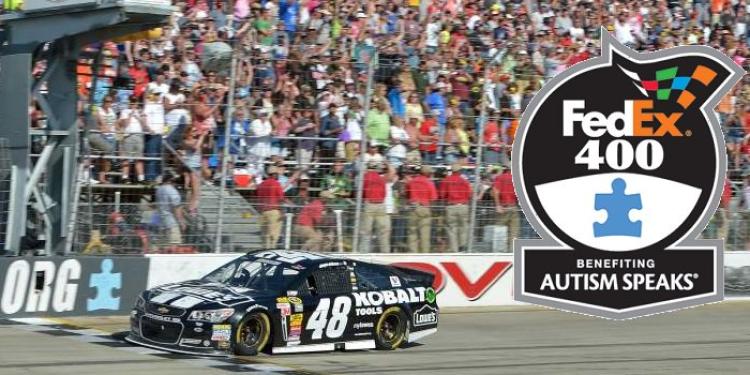An Introduction to the Fed Ex 400
Posted: June 1, 2015
Updated: October 6, 2017

A closer look at this fabulous race and how it came to exist.
The FedEx 400 benefiting Autism Speaks will begin this weekend at the Dover International Speedway in Dover, Delaware. This NASCAR race is the first of two-part Sprint cup series that will qualify for the Winston Cup standings. Qualifying will start on Friday with practice on Saturday and the main event on Sunday. The FedEx 400 is the first NASCAR Sprint Cup race giving allegiance to a non-profit organization.
The Dover International Speedway is a one-mile track that differs from the other raceways. First, Dover is the only all-concrete track in the Sprint Cup series meaning that the wear on the tires will be different. Cars have different handling on concrete than on the other asphalt tracks. The higher average speeds of the 36 cars moving side by side three and four cars wide should be enough excitement for those using online sportsbooks in the US.
Since the track is only a mile long, it’s often underrated. It shortness make driving unpredictable and tight. Tight driving usually means more contact between cars increasing the risk of accidents. Without lights for night racing, the Dover track offers other challenges as well. When the speeds accumulate, Dover is a small track that begs to be bigger. It drives more like a combination of several tracks.
Construction of the Dover Downs International Speedway began in 1966 by the Melvin L. Joseph Construction Company, Inc. The track was intended for auto and horse racing. After three years of construction the track opened. The Dover International Speed way first opened in 1969. Its first race was the Mason-Dixon 300 which was won by Richard Petty. The first two races at the track were 300 miles, but the length was raised to 500 miles in 1971.
The track remained at that length for 26 years until it was reduced to 400 miles in 1997. In 1995, the Dover track was changed to concrete. The track banks at a 24 degrees all around and 9 degrees of banking on the front and back stretch. Both straightaways are1,076 feet. In 1971, the Speedway removed all non-NASCAR sanctioned races in order to focus on two Sprint Cup races, which were 500 miles each.
In 1986, the NASCAR Budweiser Lat Model Sportsman Series, now called the Xfinity series, was add to the schedule along with an addition of 3,200 seats to its grandstand. In 1994 the Delaware General Assembly passed legislation which allowed slot machines at horse racing venues. As a result of these changes in US gambling laws, the Dover Slots also opened in the same year.
In 1998, the Dover Speedway added a Verizon Indycar series event to the schedule, but the race was removed before the 2000 racing season. In 2000, the NASCAR Craftsman Truck Series, now called the Camping World Truck Series was as to the Dover Speedway schedule. In 2002, seat capacity was brought up to 135,000 at the speedway making it the largest sports stadium in the mid-Atlantic.
In the same year the Dover Downs separated and Dover Motors was launched to oversee operations of the speedway. From 2002 the speedway would renamed Dover International Speedway. The Monster Bridge, a 56-seat, glass structure, was added over the third turn in 2004. A couple of years later the speedway formed a multi-year improvement project called “The Monster Makeover.”
A 12-suite skybox complex and new media center expansion of 2,100 were the first parts of this project. The massive expansion also included more paved disabled parking areas, expanded bus parking, renovated restrooms, improved audio quality and widened walkways behind the grandstands. In 2008, the next stage of improvement included a “Monster Monument”, 46-foot tall structure of fiberglass placed into the New Victory Plaza, emergency services and a “FanZone” section.
The front-patch pit wall was replaced with a safer barrier making the pit road safer were included a year later. Plus the overall seating capacity was reduced from 140,000 to 113,000 in order to increase the grandstand seats from 18 inches wide to 22 inches wide. Unfortunately, 17,500 seats were removed because of decline in attendance after the 2014 AAA 400. Known in US gambling news is the USD 2.9 million installation of a new, 6.4 meter catchfence for the 2015 season.
The FedEx 400 benefiting Autism Speaks will begin this weekend at the Dover International Speedway in Dover, Delaware. This NASCAR race is the first of two-part Sprint cup series that will qualify for the Winston Cup standings. Qualifying will start on Friday with practice on Saturday and the main event on Sunday. The FedEx 400 is the first NASCAR Sprint Cup race giving allegiance to a non-profit organization.
• Dover Speedway has been the only all-concrete track in the Sprint Cup series
• The first race was the Mason-Dixon 300 won by Richard Petty in 1969
• From 2002 the speedway would renamed Dover International Speedway
The Dover International Speedway is a one-mile track that differs from the other raceways. First, Dover is the only all-concrete track in the Sprint Cup series meaning that the wear on the tires will be different. Cars have different handling on concrete than on the other asphalt tracks. The higher average speeds of the 36 cars moving side by side three and four cars wide should be enough excitement for those using online sportsbooks in the US.
The unique Dover speedway track and it’s early beginnings
Since the track is only a mile long, it’s often underrated. It shortness make driving unpredictable and tight. Tight driving usually means more contact between cars increasing the risk of accidents. Without lights for night racing, the Dover track offers other challenges as well. When the speeds accumulate, Dover is a small track that begs to be bigger. It drives more like a combination of several tracks.
Construction of the Dover Downs International Speedway began in 1966 by the Melvin L. Joseph Construction Company, Inc. The track was intended for auto and horse racing. After three years of construction the track opened. The Dover International Speed way first opened in 1969. Its first race was the Mason-Dixon 300 which was won by Richard Petty. The first two races at the track were 300 miles, but the length was raised to 500 miles in 1971.
The track remained at that length for 26 years until it was reduced to 400 miles in 1997. In 1995, the Dover track was changed to concrete. The track banks at a 24 degrees all around and 9 degrees of banking on the front and back stretch. Both straightaways are1,076 feet. In 1971, the Speedway removed all non-NASCAR sanctioned races in order to focus on two Sprint Cup races, which were 500 miles each.
In 1986, the NASCAR Budweiser Lat Model Sportsman Series, now called the Xfinity series, was add to the schedule along with an addition of 3,200 seats to its grandstand. In 1994 the Delaware General Assembly passed legislation which allowed slot machines at horse racing venues. As a result of these changes in US gambling laws, the Dover Slots also opened in the same year.
Modifications were set for the renamed Dover Speedway

In 1998, the Dover Speedway added a Verizon Indycar series event to the schedule, but the race was removed before the 2000 racing season. In 2000, the NASCAR Craftsman Truck Series, now called the Camping World Truck Series was as to the Dover Speedway schedule. In 2002, seat capacity was brought up to 135,000 at the speedway making it the largest sports stadium in the mid-Atlantic.
In the same year the Dover Downs separated and Dover Motors was launched to oversee operations of the speedway. From 2002 the speedway would renamed Dover International Speedway. The Monster Bridge, a 56-seat, glass structure, was added over the third turn in 2004. A couple of years later the speedway formed a multi-year improvement project called “The Monster Makeover.”
A 12-suite skybox complex and new media center expansion of 2,100 were the first parts of this project. The massive expansion also included more paved disabled parking areas, expanded bus parking, renovated restrooms, improved audio quality and widened walkways behind the grandstands. In 2008, the next stage of improvement included a “Monster Monument”, 46-foot tall structure of fiberglass placed into the New Victory Plaza, emergency services and a “FanZone” section.
The front-patch pit wall was replaced with a safer barrier making the pit road safer were included a year later. Plus the overall seating capacity was reduced from 140,000 to 113,000 in order to increase the grandstand seats from 18 inches wide to 22 inches wide. Unfortunately, 17,500 seats were removed because of decline in attendance after the 2014 AAA 400. Known in US gambling news is the USD 2.9 million installation of a new, 6.4 meter catchfence for the 2015 season.
Related content
Subscribe
0 Comments












